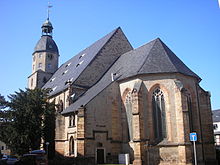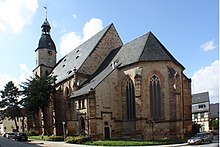St. Nikolai (Schmölln)
The Protestant town church St. Nikolai is in the town of Schmölln in the Altenburger Land district in Thuringia . It belongs to the Schmölln parish in the Schmölln parish of the Evangelical Church in Central Germany .
history
The town church of St. Nikolai was first mentioned in a document in 1159, and a church was consecrated in 1238. In the middle of the 15th century, a new hall church was started after Brand , the choir was consecrated in 1480. This church was badly damaged in a town fire in 1772, with the vaults and fittings being lost. The reconstruction was carried out using the late Gothic stock. The tower construction was completed in 1799. The building was restored in 1880, 1929–1934 and 1995. In 1986 the exterior was repaired.
architecture
Exterior
The three-aisled hall church consists of the west tower facade, the four-bay nave and the choir with five-eighth end . The choir is wider than the central nave and shifted slightly to the south from the central axis of the nave. The asymmetrical west tower facade is also shifted from the nave axis to the south. The tower has a pointed arch portal on the ground floor and a hood from 1799 at the top . To the north of the tower is an entrance porch with a larger pointed arch portal. To the south there is a lower two-storey chapel extension, which is accessed through a small pointed arch portal with cross bars. The base area is provided with an end profile and a rectangular window with cross bars. The south side of the nave is clearly highlighted by late Gothic architectural decorations such as pinnacles on the buttresses , canopies and gargoyles . The tracery windows date from 1880. To the side of the choir there is a sacristy annex in the north and an annex dated 1534 in the south with late Gothic windows, a surrounding cornice and a bracing that only occurs here. It is assumed that parts of the west building, especially the entrance section and possibly the basement of the tower, go back to the previous building from 1159. Both southern extensions were probably added soon after the late Gothic church was completed, as can be seen from the construction seams on the buttresses, the southwestern one was possibly built using the foundation and the plinth area of a previous building. The northeast cultivation is considered to be the youngest.
Interior
The interior of the nave is determined by a flat arched and plastered wooden ceiling that was pulled in after a fire. There are barrel vaults in the side aisles and a needle cap barrel in the choir . A two-storey gallery was built in 1772. The furnishings are mostly neo-Gothic from 1880. An artistically valuable, carved Vesper picture was created in 1430/1440 and has its old version, which was uncovered in 1979. The mourning Mary is shown with the body of Christ and a kneeling angel who collects the blood of Christ in a bowl. A colored crescent Madonna from around 1500 is colored and was restored in 1979.
organ
The organ was built in 1917 by the organ builders Gebrüder Jehmlich (Dresden) as op. 370 and restored in 2010 by the organ building company Jehmlich. The cone chest instrument has 54 stops (including three transmissions) on four manuals and a pedal . In addition to the swell , the chest (second manual) and the remote (playable from the third manual of the main organ) can also be swelled. The Fernwerkes registers Fernflöte and Vox humana are equipped with register tremulants. The playing and stop actions are pneumatic.
|
|
|
|
||||||||||||||||||||||||||||||||||||||||||||||||||||||||||||||||||||||||||||||||||||||||||||||||||||||||||||||||||||||||||||||||||||||||||||||||||||||||||||||||||||||||||||||||||||||
- Coupling : I / I (super octave coupling), II / I, III / I, III / II (also as sub and super octave coupling), III / III (super octave coupling), I / P, II / P, III / P (also as Tenor coupling)
literature
- Georg Dehio: Handbook of the German art monuments. Thuringia. 1st edition. Deutscher Kunstverlag Munich / Berlin 1998, ISBN 3-422-03050-6 , pp. 1118–1119.
Individual evidence
- ↑ Welcome to Schmölln / Thuringia: City Church. Accessed on December 29, 2013
- ↑ Information about the organ on the website of the organ builder Jehmlich
Web links
Coordinates: 50 ° 53 ′ 44 ″ N , 12 ° 21 ′ 15 ″ E


